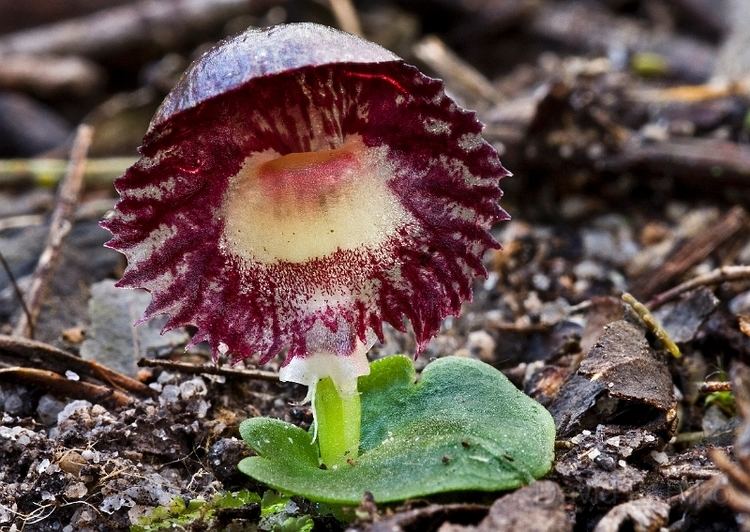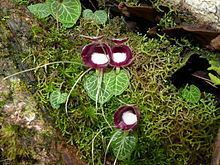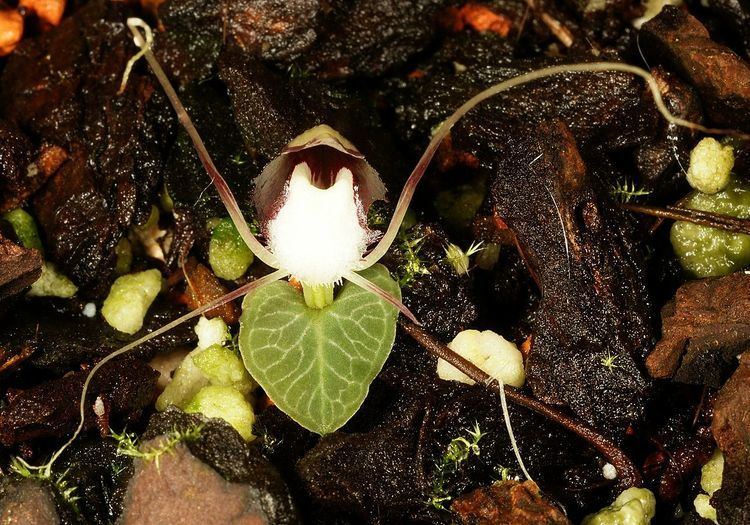Family Orchidaceae Rank Genus | ||
 | ||
Similar Pterostylis, Acianthus, Microtis, Chiloglottis, Cryptostylis | ||
Corybas, commonly known as helmet orchids, is a genus of about 120 species of plants in the orchid family, Orchidaceae. Helmet orchids are small, perennial, deciduous herbs and are nearly always terrestrial. They have a single leaf at their base and a single flower on a short stalk, the flower dominated by its large dorsal sepal and labellum. Species of Corybas are found in Australia, New Zealand, New Guinea, Southeast Asia, the Himalayas, southern China, many Pacific islands and a few sub-Antarctic islands.
Contents
Description

Orchids in the genus Corybas are perennial, deciduous, sympodial, usually terrestrial herbs, lacking roots. (A few sometimes grow as epiphytes on the fibrous bark of tree ferns or on the mossy branches of trees.) They have an underground tuber which is more or less spherical and fleshy. New tubers form at the end of root-like stolons. There is a single, heart-shaped, kidney-shaped or almost round leaf, usually at ground level and a short erect stem with a single flower at the top.

The flower has a short stalk with a small, leaf-like bract at its base. The flower is resupinate, dull-coloured and resembles the fruiting body of a fungus. The dorsal sepal is much larger than the lateral sepals and petals and curves forward, often forming a hood over the column. The lateral sepals and petals are small, linear to almost thread-like. As is usual in orchids, one petal is highly modified as the central labellum and in this genus is often the most obvious part of the flower. The labellum is large, deeply concave or tube-shaped with its base attached to the base of the column and sometimes completely surrounding the column. Sometimes there is a pair of small, ear-like appendages on either side, near the base. The column is small, enclosed by the base of the labellum and has small wings. In temperate regions, flowering occurs between autumn and spring and in tropical regions in most months. The fruit that follows flowering is a non-fleshy, dehiscent capsule containing up to 500 seeds. As the fruit matures, the flower withers and the flower stem elongates to a length of up to 30 cm (10 in), aiding in seed dispersal.
Taxonomy and naming

Corybas aconitiflorus was first formally described by Richard Salisbury, allegedly from a colour plate prepared by Ferdinand Bauer and thus became the type species for the genus. The description was published in The Paradisus Londinensis. Salisbury stated that the name of the genus was derived from similarity of the flowers to the covered head of a Greek κορύβαντος (korybantos), a male dancer, shown in illustrations wearing a crested helmet, who worshipped the goddess Cybele. Korybas was a priest of Cybele, "whose religious rites were accompanied by frenzied music and dancing".
Ecology

Pollination appears to be achieved by small insects, possibly mistaking the unusual flowers for fungi. Helmet orchids have not often been studied, partly because of their short-lived, inconspicuous flowers but also because the flowers are difficult to preserve as herbarium specimens. Many form clonal colonies but it is not known whether this is a characteristic of all species.
Distribution and habitat

Helmet orchids grow in India, South China, Taiwan, the Malay Peninsula, Borneo, the Philippines, New Caledonia, Vanuatu, Ponape, Indonesia, New Guinea, the Solomon Islands, Australia (including Macquarie Island), New Zealand (including Chatham, Stewart, Auckland and Campbell Islands), Tahiti, Samoa and the Society Islands. Australian species usually grow in moist, shady places, often with dense moss or on rotting logs, sometimes with orchids from other genera.
Species
As of July 2016, the World Checklist of Selected Plant Families accepts the following species and natural hybrids:
